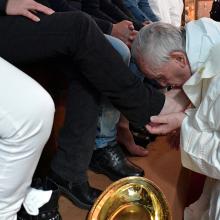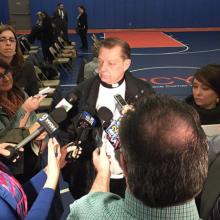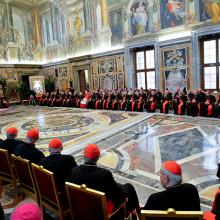Rome
IN FALL 2014, the St. Louis Symphony Orchestra performed Brahms’ Requiem on a Saturday evening two months after the murder of Michael Brown Jr., at a concert hall about 10 miles from Canfield Green, where Brown was killed and his adolescent body left out in the Missouri August sun for four and a half hours.
That summer and fall, people in the city and county of St. Louis lived in the tension of waiting — we were waiting for a grand jury to make a decision. Not a verdict about the officer’s guilt: The grand jury was tasked with deciding whether this murder was even a murder at all — whether anything happened on Aug. 9 that could even be considered maybe a crime. Maybe worth investigating. Or whether it was just a regular day’s work.
As intermission was ending and folks were back in their seats, just as the orchestra was regathered and the conductor was raising his baton, a small group of ticketholders in the audience stood up and sang. In singing, they asked the audience, made up largely of people who could choose whether or not they were impacted by the grand jury’s decision that loomed over the city like the shadow of death, to make a decision of their own. They stood up, one by one, and joined their voices in an old labor song: “Which side are you on, friend, which side are you on?” they sang. “Justice for Mike Brown is justice for us all. Which side are you on, friend, which side are you on?” They hung banners made of bedsheets over the balcony; one that echoed the piece being performed that evening was painted: “Requiem for Mike Brown, 1996-2014.”
These protesters brought this question — this disruption — into a space that could’ve kept it to business as usual. They sang the two refrains in repetition, almost like a Taizé chant, for several minutes, then they left the hall together, chanting a chant that at the time was still brand-new to most Americans: Black Lives Matter.
The disrupters left to a mix of silence and applause from the audience and the musicians. The concert continued, but the question hung in the air. It’s the same question that hangs in the air of many of Jesus’ disciple-calling stories, and it’s certainly the question that pervades Matthew’s telling of Jesus’ good news.
Pope Francis was delighted when a young boy stormed onto the stage during his general audience on Wednesday, in which he addressed the topic of dialogue between young and old people.
Pope Francis said on Monday he was willing to go to Moscow to meet Russian Orthodox Patriarch Kirill “brother to brother” in what would be the first trip by a pope to Russia.
Father Benigno Palilla, an exorcist for the diocese of Palermo, told Vatican Radio in February that he had performed about 50 exorcisms in the past two and a half years.
Since his election in 2013, Francis has several times called for an worldwide ban on capital punishment, prompting criticism from Church conservatives, particularly in the United States.
God’s kingdom is a place of unlimited love and unending compassion. It’s a place where everyone is welcomed — especially the marginalized — and nobody is treated like an outcast.
Pope Francis used his traditional Easter Sunday message to call the bombing of a refugee convoy near Aleppo, Syria, a “despicable attack”, and urged world leaders to “prevent the spread of conflicts” despite mounting tensions in Syria and North Korea.
In his Easter blessing, known as “Urbi et Orbi” (“to the city and the world”), the pope urged the faithful to remember “all those forced to leave their homelands as a result of armed conflicts, terrorist attacks, famine, and oppressive regimes.”
"We are all sinners. We all have defects," the pope told the inmates, in an improvised sermon broadcast by Vatican Radio.
By washing their feet, Francis told them, he was willing to do "the work of a slave in order to sow love among us". He urged them to help each other.
Two of the 12 are serving life sentences, and the others are due to be released between 2019 and 2073.
First came the showers and the haircuts. Now the washing machines.
In his latest bid to help the poor with practical actions, Pope Francis has opened a free laundromat for the homeless in the heart of Rome.
Since he became pope four years ago, Francis has made it a personal priority to provide them with showers, housing, medical care, and other services to help restore their dignity.
With the blessing of Pope Francis, Cardinal Blase Cupich on April 4 unveiled an anti-violence initiative for this beleaguered city that will be underscored by a Good Friday procession, using the traditional stations of Jesus’ way to the cross to commemorate those who have lost their lives in street violence.
Cupich said he was inviting civic, education, and religious leaders, and “all people of good will,” to take part in the April 14 “Peace Walk” through the heart of the violence-scarred Englewood neighborhood.
Italian archaeologists have discovered the remains of 38 skeletons buried in a Jewish cemetery in Rome more than 500 years ago, offering further evidence of their ubiquity and persecution under papal rule.
The well-preserved skeletons were found during excavations beneath a building, in an area identified on ancient maps as “Campus Iudeorum” — Latin for “Field of Jews” — in the Trastevere quarter of Rome, just across the Tiber River from the Italian capital.
During our nearly 40 years of friendship, I led several interreligious missions with Keeler, including meetings with then-Pope John Paul II at the Vatican. We co-led trips to Israel, including a visit to a civilian bomb shelter, and a poignant painful pilgrimage to the infamous death camps of Auschwitz-Birkenau.
Sometimes public figures can seem distant and impersonal, but that was never the case with the always gracious and welcoming Keeler.
As Pope Francis marks the fourth anniversary of his revolutionary papacy, the pontiff apparently finds himself besieged on all sides by crises of his own making: an open “civil war” in the Catholic Church and fears of schism, mounting opposition from the faithful, and a Roman Curia so furious with his reforms that some cardinals are plotting a coup to topple him.
President Trump’s proposed border wall with Mexico raises serious questions about America’s moral standing, as the poor would bear the brunt of the suffering, a leading Catholic theologian says.
The Rev. Daniel G. Groody, an associate professor of theology at Notre Dame University in Indiana, said the wall would lead to a loss of life, as migrants are forced to find other ways to escape poverty across the border.
“What Trump fails to see is that state sovereignty is not an absolute privilege, but a moral responsibility,” said Groody.
“Pope Francis has a lot of explaining to do by approving the newest Vatican instruction,” said Francis DeBernardo, executive director of New Ways Ministry, which campaigns for LGBT rights in the church.
“Francis’ famous ‘Who am I to judge?’ statement in 2013 was made in response to a question about gay men in the priesthood,” DeBernardo said. “That response indicated very plainly that he did not have a problem with a gay priest’s sexual orientation.
If I’ve learned anything since my time in Rome, it’s that people — not just Catholics — are hungering to connect peace with justice. This is why those of us who traveled to Rome just before the election, accompanied by Stockton, Calif., Bishop Stephen Blaire, and Houma-Thibodaux, La., Bishop Shelton Fabre, are preparing for a regional WMPM meeting in Modesto, Calif., in February.
Pope Francis on [Nov. 11] made a surprise visit to meet several men who took the controversial step of leaving the priesthood and starting a family.
A Vatican statement said the pope left his residence in the afternoon and traveled to an apartment on the outskirts of Rome, where he met seven men who had left the priesthood in recent years. The pontiff also met their families.
In the summer of 430, the great Christian writer and bishop Augustine of Hippo lay dying as barbarians besieged his North African city – basically a mop-up operation in the slow-motion fall of the Roman Empire.
Today, in the fall of the year 2016, a lot of Christians can relate.
Even by this pope’s standards it was a bold move.
Francis, the spiritual leader of more than a billion Roman Catholics across the globe, this week traveled to Sweden, one of the most secularized countries in Europe, to take part in events marking 500 years since Martin Luther kickstarted the Protestant Reformation.
The strongest earthquake to strike Italy in more than three decades claimed no lives, but struck at the heart of the country’s vast religious and cultural heritage.
The Oct. 30 quake, which measured 6.6 magnitude according to the U.S. Geological Survey, was stronger than the one that killed almost 300 people on Aug. 24, and it struck a region already shaken by tremors last week.



















